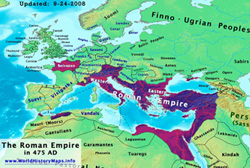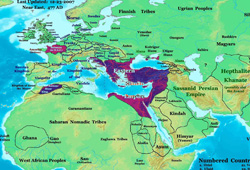AH 475ad Background and Story Timeline:
Our Time Line (OTL):
In 475 AD, the Western Roman Emperor Julius Nepos was deposed by a general named Orestes, who then installed his own son (Romulus Augustulus) as Emperor. Emperor Nepos fled to Dalmatia, holding out as a rival Emperor from his capital city in Split.
In 476 AD, Orestes was killed during a revolt of Germanic Federates led by a general named Odoacer, who then deposed Emperor Romulus Augustulus. Instead of recognizing Julius Nepos as Emperor, Odoacer sent the Western Imperial regalia to the Eastern Roman Emperor, Zeno. In return Zeno granted Odoacer the title of "Patrician", in theory allowing Odoacer to rule Italy as an agent of the Eastern Empire. In reality Odoacer ruled Italy as a King in his own right. Most scholars consider this the official end of the Western Roman Empire and the beginning of the Medieval "dark ages". |
Map of the Roman Empire |
Map of the Roman Empire |
Emperor Julius Nepos continued to hold out in Dalmatia until 480 AD, when he was assassinated by agents of Odoacer. Dalmatia was then incorporated into Odoacer's Kingdom. I consider this to be the end of the Western Roman Empire.
The last fragment of the Western Roman Empire was the "Dominion of Soissons" in Gaul, ruled by Duke Syagrius. In 486 AD, Syagrius was defeated by King Clovis of the Franks, who then occupied Soissons. Syagrius fled to the Visigoth Kingdom in Aquitaine, but was soon betrayed by them and given to Clovis, who executed him in 487 AD.
It was a sad end to one of the greatest and longest-lived imperial systems in human history. |
AH 475ad Timeline:
In AH 475, Odoacer allied with Emperor Julius Nepos instead of general Orestes, who was defeated and executed. Odoacer then became magister militum (supreme general) of the Western Roman Empire, which by now was reduced to Italy, Dalmatia, and the "Dominion of Soissons" in NW Gaul (ruled by Duke Syagrius).
In AH 477, Odoacer defeated the Vandals and recaptured Sicily.
In AH 480, Emperor Nepos was assassinated and Odoacer became the Regent for his infant son and heir (?Augustus Nepos?).
In AH 481, Odoacer defeated the Visigoths and brought Provence back under Imperial control.
In AH 486, Duke Syagrius was defeated by King Clovis of the Franks. The Visigoths blocked Syagrius' retreat to Imperial lands, and Syagrius was forced to flee with his remaining army to Armorica (Brittany). After King Clovis threatened to invade Armorica, Syagrius fled to Britain where he found service helping the Romano-Britons defend their lands from the Anglo-Saxon invaders.
In AH 487, Odoacer defeated the Rugians and re-occupied Noricum up to the banks of the Danube. Instead of destroying the Rugians, Odoacer incorporated them into his army as Federates.
In AH 488, Odoacer deposed the young Emperor Augustus Nepos and declared himself the first Germanic Emperor of the Western Roman Empire. In response, the Eastern Roman Emperor, Zeno, commissioned the Federate Ostrogoths under King Theodoric to invade Italy on the Empire's behalf. Odoacer was defeated twice, then died during the Ostrogothic siege of Ravenna in 493.
Emperor Zeno didn't appoint a new co-Emperor for the West. Instead he kept the crown to himself and appointed Theodoric magister militum of the west. Theodoric was kept busy fighting Frankish expansion, especially after King Clovis defeated and killed the Visigoth King Alaric II and annexed Aquitaine in 507. Theodoric was able to help the Visigoths keep Septimania (the Mediterranean coast of Gaul) and hold it against two Frankish invasions. In 510 Theodoric defeated the Vandals and seized the island of Corsica, though he was prevented from taking Sardinia because of an Alemannian invasion of Italy.
In AH 515, Emperor Anastasius I appointed a Roman general from Illyria named Justin as Western Emperor. Justin began a policy of consolidation in the West, reforming the army, rebuilding the navy, and establishing a series of fortresses along the frontier zones. He also initiated forced transfers of Germanic tribes living within the Empire. The end result of Justin's work was that he left a much stronger Western Empire to his nephew, Justinian I, who inherited the Western Roman throne in 527.
Emperor Justinian I began a massive effort to re-establish Roman supremacy in the West. In 533 his great general Belisarius invaded the Vandal Kingdom in Africa, destroying their army and taking Carthage in 534. The last Vandal holdouts in Africa and the Balearic Islands fell in 535. Next Justinian was forced to fight a war against the Franks in Burgundy. Belisarius defeated the Franks in a hard-won campaign from 536 to 539, which restored Burgundy to the Western Empire.
In AH 542, Justinian sent Belisarius against the Visigoth Kingdom in Iberia. Despite a fierce resistance by the Visigoths, the local population welcomed the return of the Romans. The Visigoth King Theudis was defeated near Saragossa, while another Roman army seized Cartegena. The Visigoth capital of Toledo fell in 545, and King Theudis was finally defeated and killed near Seville in 546. The last Visigoth warlords surrendered in 548.
In AH 548, the Franks attacked the Romans in Septimania and Burgundy, but Belisarius drove them back and seized the city of Lyons in 550.
In AH 552, the Eastern Emperor (?Idunnowho?) died and his sons soon began to fight for the throne. The Sassanid Persians took advantage of this and seized several cities including Antioch. The younger brother treacherously murdered his older brother and ordered an army to stop the Persians, but that army revolted and asked Justinian to accept the throne. Justinian accepted and was proclaimed Emperor of the East and West in 554, thus re-uniting the Roman Empire. Belisarius led a series of counter-attacks against the Persians, winning a significant victory in 563 that restored the Eastern frontier. The "Great Roman-Persian War" now over, Justinian prepared to throw the full weight of his armies against the Franks. Alas, it was not to be...
In AH 565, Emperor Justinian I died and was succeeded by his son, who became Emperor Justin II.
In AH 568, the Germanic Lombards invaded Noricum and attacked Italy. They plundered several cities along the Po valley, but were unable to occupy the key fortresses of Northern Italy. The Lombards were driven back across the Alps by 575, though they retained Noricum and parts of Venetia.
In AH 569, the Avars and Kutrigurs invaded the Balkans, wreaking havoc in Illyria and Moesia before being driven back across the Danube in 571. A far worse invasion of Slavic tribes occured almost immediately afterwards. Poorly-manned fortresses in the Balkans were quickly overrun. Soon Imperial control was limited primarily to coastal stations and the most important fortresses inland.
* More to come, stay tuned...!

